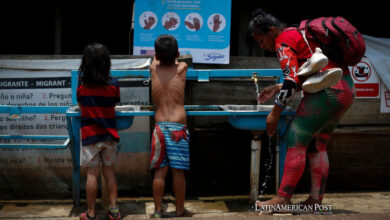Previously Impenetrable, the Darién Gap is Now a Perilous Path for Migrants

The Darién Gap, long considered impenetrable, has become a critical route for migrants fleeing desperate situations in Latin America. As more people risk their lives crossing this treacherous jungle, the global implications of this migration crisis are becoming increasingly dire.
The Darién Gap, a dense, dangerous stretch of jungle connecting northern Colombia to southern Panama, has long been a formidable obstacle for explorers, engineers, and adventurers. Throughout history, various attempts have failed to conquer or navigate this inhospitable terrain. From Spanish explorers to modern-day surveyors, the Gap has remained a nearly impenetrable barrier, challenging those who have tried to tame it.
One of the earliest attempts to colonize the region was by the Scottish in the late 17th century, an endeavor that nearly bankrupted Scotland. Later, surveyors viewed the narrow 110-mile isthmus as a logical location for a canal to connect the Atlantic and Pacific Oceans. However, the Darién’s treacherous environment proved too challenging to overcome. In 1854, a group of U.S. Navy engineers attempted to find a canal route through the region, only to become lost; seven of them starved to death.
The dangers of the Darién Gap were further highlighted during the construction of the Pan-American Highway in the 1930s. The highway, which was intended to connect the Americas, remains incomplete through the Darién. The missing 66-mile link has since become known as the “Darién Gap,” symbolizing the region’s enduring challenges.
Starting in the 1990s, the Darién became a refuge for Marxist FARC guerrillas and right-wing paramilitary groups. Its isolation, combined with a lack of government control, made it an ideal location for armed groups to operate. The Gap became a crucial route for moving weapons and drugs, and anyone venturing into the area without permission risked kidnapping or worse. Despite the FARC’s retreat following a peace deal with the Colombian government and the official demobilization of the paramilitary groups in the mid-2000s, the region remains controlled by criminal organizations like the Urabeños, who now dominate large sections of the Gap.
A Dangerous Migration Route
While the Darién Gap has historically been viewed as impassable, it has become a critical route for migrants hoping to reach the United States. More than 800,000 people are expected to cross the Darién Gap this year—a more than 50% increase from last year’s staggering numbers. The majority of these migrants are fleeing desperate conditions in their home countries, and children under the age of five are the fastest-growing group among them.
The U.S. has spent years attempting to curb migration by pressuring Latin American countries to close off established routes and deny visas to those trying to enter the U.S. through countries close to its border. However, instead of stopping migration, these efforts have only rerouted migrants through the Darién Gap. The responsibility for managing this migration has increasingly fallen on criminal organizations, which have capitalized on the situation.
The Gulf Clan, now called the Ejército Gaitanista de Colombia, effectively controls this part of northern Colombia. Traditionally involved in the movement of drugs and weapons, the cartel has expanded its operations to include human trafficking. They have established infrastructure throughout the Gap, including staircases on hillsides, ladders on cliffs, and camps equipped with Wi-Fi. These services are even advertised on TikTok and YouTube, allowing migrants to book their journeys online.
The routes through the Darién Gap vary in difficulty and cost. The most grueling path—traveling through the jungle on foot—currently costs about $300 per person. Those who can afford more may opt for a boat trip up the coast, costing upwards of $1,000. Despite the high cost and extreme risks, hundreds of thousands of migrants continue to attempt the journey each year.
The Human Toll of Migration Through the Darién Gap
The journey through the Darién Gap is one of the most dangerous migration routes in the world. The jungle is dense and mountainous, and daily rains cause flash floods that can wash away entire groups of people. Migrants face a host of natural threats, including deadly snakes and jungle cats, and the physical toll of traversing steep, rugged terrain. Heart attacks from overexertion are common, and many migrants run out of food and water long before they reach the other side.
In addition to the natural dangers, migrants must also contend with human threats. Robbery and sexual assault are frequent occurrences along the route, as criminal gangs prey on vulnerable travelers. Panamanian authorities regularly recover bodies from the jungle, but many more are never found, swallowed up by the unforgiving environment.
The harrowing experiences of migrants who have made the journey highlight the desperation that drives them to attempt such a perilous crossing. Even those who are relatively healthy and prepared often find themselves overwhelmed by the challenges of the Darién. For families with young children, the risks are even greater. A young girl named Susej was traveling through the Darién with her mother after fleeing Venezuela. Like many others, they had tried resettling in other parts of Latin America, only to find the economic conditions untenable. With few options left, they turned to the Darién as a last resort.
Despite the dangers, many migrants are unaware of the full extent of the risks before embarking on their journey. Smugglers often downplay the challenges, misleading people into believing that the crossing will be easier than it actually is. Once in the jungle, however, the reality quickly sets in. Migrants are forced to navigate an unpredictable and treacherous environment with little to no support.
The Global Implications of the Darién Migration Crisis
The migration crisis in the Darién Gap is not just a regional issue—it has global implications. While efforts by the U.S. to curb migration at its southern border have led to a significant drop in illegal border crossings from Mexico, this has done little to stem the flow of migrants through the Darién Gap. The underlying causes of migration—political instability, economic collapse, and violence in countries like Venezuela—continue to drive people to take extreme risks in search of safety and opportunity.
Attempts to stop migration by making it more difficult have failed to achieve the desired results. Instead, these efforts have only increased the power and influence of criminal organizations, who profit from the desperation of migrants. As more people attempt the crossing each year, the human toll continues to rise.
The challenges facing the international community in addressing this crisis are significant. The United Nations has tried to warn migrants of the dangers ahead by stationing officials at bus stations and other checkpoints along the route to the Darién Gap. However, these efforts have been largely ineffective. Migrants, driven by a sense of desperation, are willing to take extraordinary risks to reach their destination.
In many cases, migrants are unaware of the policies and restrictions in place at the U.S. border. While some migrants had heard of the CBP One app—a tool introduced by the Biden administration to allow people to apply for permission to fly to the U.S. border and seek asylum—many were unaware of the tougher restrictions implemented in June. For those fleeing life-or-death circumstances, these policies are often irrelevant. Their primary concern is survival, and they will continue to seek any route that offers the possibility of a better life.
The situation in the Darién Gap underscores the complexity of the global migration crisis. While efforts to address the root causes of migration have had some success in reducing flows from Central America, conditions in other parts of the world have worsened, leading to increased migration from countries like Venezuela, Haiti, and Ecuador. This shifting dynamic highlights the challenges of managing migration on a global scale, where efforts to address one crisis often lead to the emergence of new ones.
A Call for Global Action
The migration crisis in the Darién Gap is a stark reminder of the human cost of forced migration. The dangers faced by migrants in the jungle are a consequence not only of the harsh environment but also of the flawed policies that have failed to address the root causes of migration. The situation is likely to worsen in the coming years, with more people attempting the journey and more lives being lost.
Addressing this crisis will require a coordinated global response. Wealthy nations, including the United States, must recognize that making migration more difficult does not stop people from fleeing desperate situations. Instead, it pushes them into the hands of criminals and increases the risks they face along the way. To truly address the issue, the international community must focus on improving conditions in migrants’ home countries, providing safe and legal pathways for those seeking asylum, and holding criminal organizations accountable for their exploitation of vulnerable people.
Also read: Biden’s Expanded Refugee Program Transforms Latin American Migration
As the number of migrants crossing the Darién Gap continues to rise, the need for action becomes increasingly urgent. The world cannot afford to turn a blind eye to the suffering of those who are forced to risk their lives in search of safety. It is time for a new approach—one that prioritizes human rights and dignity, and that addresses the underlying causes of migration rather than merely treating its symptoms. The stakes are too high to do otherwise.





